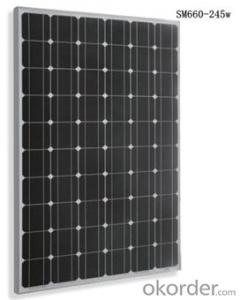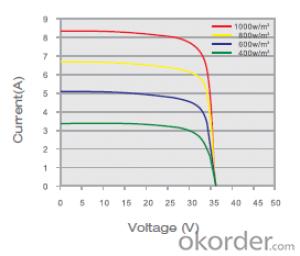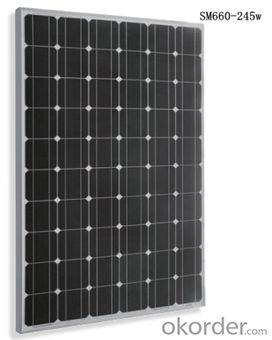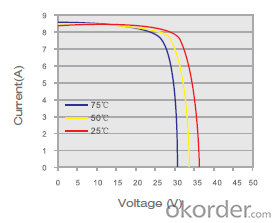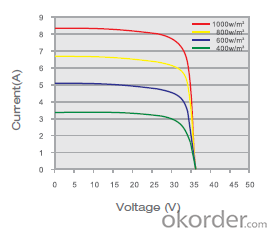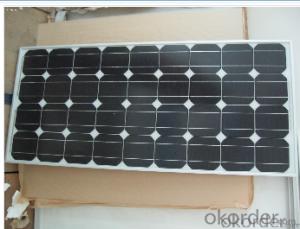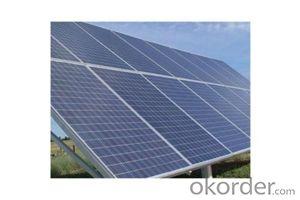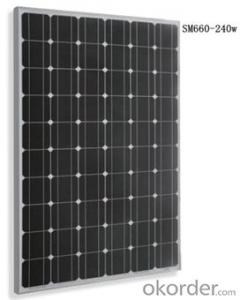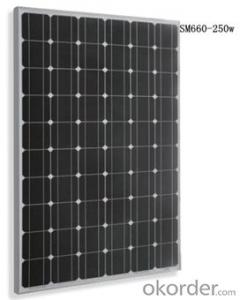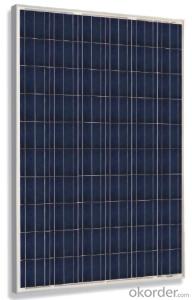Solar Panels Hawaii Monocrystalline Solar Module SM660-245W
- Loading Port:
- Shanghai
- Payment Terms:
- TT OR LC
- Min Order Qty:
- 25 set
- Supply Capability:
- 8000 set/month
OKorder Service Pledge
OKorder Financial Service
You Might Also Like
Product Description:
1.Structure of Monocrystalline Solar Module SM596 245W Series Description:
Monocrystalline Solar Module SM596 245W: High efficiency crystalline solar cell. Even if under the weak light, the solar module can produce maximum power output.
II Tempered glass (toughened glass): Anti-reflecting coating and high transmission rate glass increase the power output and mechanical strength of solar module.
III EVA and TPT: Using high quality EVA and TPT to prevent destroying and water.
IV AI frame: Without screw, rner connection. 6 holes on the frame can be installed easily.
V Junction box: Multi function junction box with water proof.
VI Long lifetime: ≥25 years; Less power decrease.
VII Good performance of preventing from atrocious weather such as wind and hails.
VIII Resisting moisture and etching effectively, not effected by geology.
IX The certificate issued by international authority: TUV, IEC, CE.ISO9001.MCS
2. Standard Test Conditions of Monocrystalline Silicon Solar Panel:
The opto-electrical specifications shown below are stabilized values being measured at Standard Test Conditions, Irradiance: 1000W/m2, Spectrum: AM1.5 at 25°C, The info below is subject to manufacturing tolerances. Where appropriate minutes of measurement are available and are used for the dimensioning of the installation.
Advantages of Polycrystalline Silicon Solar Panel
• 25 year transferrable power output warranty: 10 years / 90%, 25 years / 80%*
• 12 year material and workmanship warranty
• Timeliness of delivery
• Quality Products certified (TUV, IEC, CE.ISO9001.MCS)
3. Characteristics of Monocrystalline Silicon Solar Panel:
• Guaranteed tolerance +3%
• High manufacture standards
• Reliable power output
• High module efficiency
• Module efficiency up to 15.5%
• Cells efficiency up to 17.6%
• Strong compressive strength
• Certified to withstand high wind of 2400Pa
4. Solar Panel Images

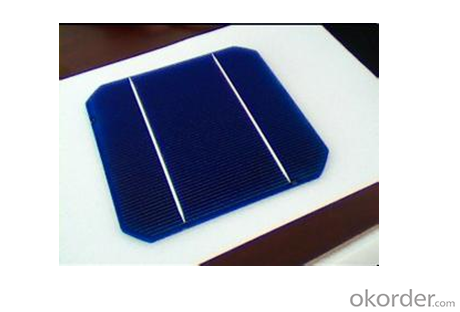


5. Monocrystalline Silicon Solar Panel Specification
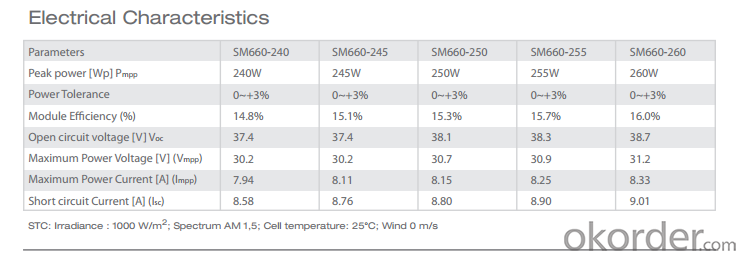
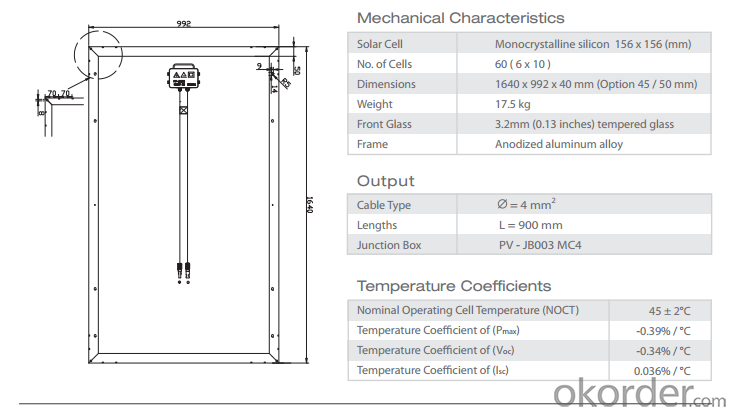


6.FAQ
We have organized several common questions for our clients,may help you sincerely:
①How about your company?
We are a private-owned high-tech company who specializes in developing, manufacturing and marketing of silicon ingots, solar wafer, solar cells, solar modules, PV systems and solar applications products.
At present, We has one research & development team, whose members are well-known experts in photovoltaic area. We also have advanced production and test equipment.
②How to guarantee the quality of the products?
Our products have been certified by CE, CEC,MCS, IEC61215, IEC61730 and ISO9001.
• 25 year transferrable power output warranty: 10 years / 90%, 25 years / 80%*
• 12 year material and workmanship warranty
• Timeliness of delivery
• Quality Products certified (TUV, IEC, CE.ISO9001.MCS)
③How long can we receive the product after purchase?
In the purchase of product within three working days, We will arrange the factory delivery as soon as possible. The pecific time of receiving is related to the state and position of customers.Commonly 7 to 10 working days can be served.
- Q: Can solar panels be installed on assisted living facilities?
- Yes, solar panels can be installed on assisted living facilities. In fact, installing solar panels on these buildings can be highly beneficial as it can help reduce energy costs, promote sustainability, and contribute to a greener environment. Additionally, solar panels can provide a reliable source of renewable energy, helping to ensure a more reliable power supply for the facility and its residents.
- Q: How do solar panels affect the power grid?
- Solar panels can positively impact the power grid by producing clean and renewable energy. When connected to the grid, excess electricity generated by solar panels can be fed back into the system, reducing the overall demand for traditional fossil fuel-based power sources. This not only helps in reducing greenhouse gas emissions but also decreases the strain on the power grid, making it more reliable and sustainable.
- Q: I remember hearing somewhere that solar panels may attract light rays away from plants thus having a potentially negative effect on the plants. I can't remember where I heard it but I'm curious if there is any truth to it.
- solar panels don't literary attract light but when the light hits it it turns into stored energy planets dont give of heat or ray if u mean stars like the sun yes. it doesn't have anything to do with planets its star noble gases that stuff u can steal light it just gets it other than wasting it solar panels are better than those factory thingys
- Q: i have a small solar panel,the ones from a garden lamp that turns on at night-i think.what i was wondering is can i just connect the solar panel to a capacitor and then a light just to test?or do i need something to convert the solar energy to usable energy?and how do i tell if a capacitor is broken?
- you don't need a capacitor. You can connect it to a light directly. Capacitors rarely break. You can check with an ohmeter.
- Q: I'm doing a project for school and I'm a little confused about energy and solar panels. I'm looking to propose installation of solar panels to power the computer lab at my school. From what I've read a computer and monitor use roughly 350 watts per hour. I was looking at solar panels and it says they produce various wattage. For example, I was looking at one rated at 200 watts. Does that mean 200 watts in a day? Or per hour? Please help.
- The rating of a solar panel is a maximum continuous rating. A 200 Watt panel will give a maximum of 200 watts under ideal conditions. A computer and monitor use about 400 Watts. not per hour - watts is Volts * Amps and a measure of Power. In hour a computer and monitor uses 400 Watt hours (Wh). Wh is a measure of Energy. To power a lab of 0 computers you will need 0* 400 = 4000 Watts. To run this from solar panels through the day only you would need a 4000 Watt panel. Except - its cloudy, the sun is in the wrong place - many factors reduce the output. To be reasonably safe you would need about a 2000 Watt panel. Then you would need batteries to store power through dull periods AND a voltage converter to change from low voltage DC from the solar panels to the mains voltage for your computers.
- Q: What's the best deal going on companies leasing out Solar Panels in California?
- you have been very mislead by someone. Or ? did you listen to a Obama speech or something ? EDIT ; thanks for response via e mail. But if you think you can save money by, renting solar panels , then you are a very ignorant person. The only way that a scheme would would work ,is if the company that is leasing the panels to you ,,have bribed lobbied the local or fed politicians to get subsidized to provide the panels. then they get payed to install them and guaranteed to make a profit by the gov. for green energy that is why you have to pay 25 cents , while most people pay 0 cents , because you subsidizing all the profits of these Professional thieves. Who's job is to find new ways to get into that deep pool of public dollars,,tax dollars . Question for you .. Do really think the rented solar panels will? ) pay for installation 2) pay for the cost to buy the panes 3) pay the sales commission to the people that sold it to you 4) pay the on going commission to those that over see them 5) Add to that the higher rate on your elec bill to pay for these people to be subsidized , so they can rent you some solar panels ??????? Like I said ,,,,,,,you must be very ignorant about energy. Or very Ignorant about the thousands of companies that are formed to succk tit of the tax payers. You are ignorant on both of those points. So dont get piisssed of at me for answering your question !!!!! Instead , you should ask why you are so easily led ? Why you are so easily fooled by the users ? That is those that use the gov to use ignorant people like you. HAHAHAAH. And you fell for the whole scam without even realizing it That is why I use the word ignorant ,, because you are. If you dont know what ignorant means google it to find out. because you are,
- Q: Okay so.. if light deflect the light of the sun and black absorbs it, then aren't solar panels just absorbing more light, sun and heat into our atmosphere? Wouldn't this lead to an increase in global warming? Shouldn't solar panals be white? No rude answers please.
- If the panels are deployed at outer surface of atmosphere then white will reflect the sun light to outer space. If the panels are deployed at earth surface, inside the atmosphere, most of the reflected light will be bounced back to earth by the atmosphere. For the solar panels we are talking about, they need to be dark color to absorb light and turn into electricity.
- Q: If not how do they give power to a house/a company?
- No they don't have an outlet. The wires attached to the solar panel can be attached to say a battery and keep it charged during day even during.use. At night you use battery power.
- Q: Can solar panels be installed on multi-story buildings?
- Yes, solar panels can be installed on multi-story buildings. In fact, multi-story buildings can provide ample space for solar panel installations, allowing for increased energy generation and potential cost savings. However, it is necessary to consider factors such as available roof space, structural integrity, and shading issues to ensure optimal positioning and efficiency of the solar panels.
- Q: How do solar panels affect the property's overall sustainability?
- Solar panels can significantly enhance a property's overall sustainability by harnessing renewable energy from the sun. They reduce dependence on fossil fuels, decrease carbon emissions, and contribute to energy independence. Additionally, solar panels can generate surplus electricity that can be sold back to the grid, further enhancing the property's sustainability and potentially providing financial benefits.
Send your message to us
Solar Panels Hawaii Monocrystalline Solar Module SM660-245W
- Loading Port:
- Shanghai
- Payment Terms:
- TT OR LC
- Min Order Qty:
- 25 set
- Supply Capability:
- 8000 set/month
OKorder Service Pledge
OKorder Financial Service
Similar products
Hot products
Hot Searches
Related keywords
